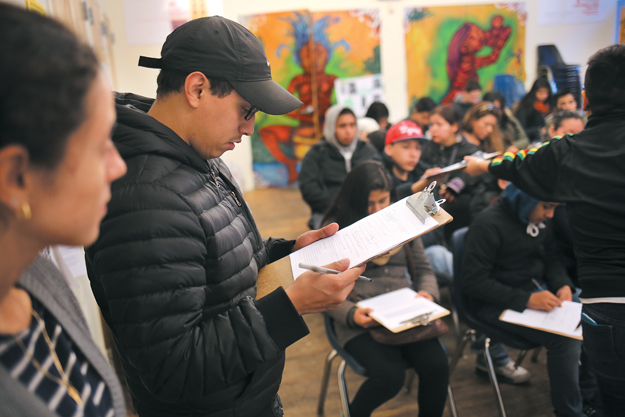President Barack Obama put immigration front and center on the U.S. national agenda with his announcement last November that he would take executive action to protect several million undocumented immigrants from deportation, among other things. But instead of focusing on how his plan will make our communities safer and more prosperous, the debate has been obscured by partisanship.
No one denies that our nation’s immigration system is broken. Currently, there is no fair and responsible way to deal with the estimated 11 million people who are living, working and raising families in the U.S. without documentation.
In the absence of immigration reform in Congress—a structural fix we still need—two programs created by executive action aim to address this problem. The expansion of the 2012 Deferred Action for Childhood Arrivals (DACA) for immigrants brought to the U.S. as children, and the new Deferred Action for Parents of Americans and Lawful Permanent Residents (DAPA) could together affect up to 5 million eligible individuals, allowing them to work legally in the U.S. for three years, with the option to renew their status. By making it easier for immigrants to work and contribute to our economy, these reforms will lead to greater economic opportunity for all Americans.
Cities feel the positive impact of immigration most directly and are leading the effort to support the implementation of executive action, as well as a long-term solution for reform. Mayors from more than 50 cities—from San Francisco to Atlanta, Chicago to Salt Lake City—have joined together to form the Cities United for Immigration Action (CUIA) coalition.
This is a coalition rooted in action. Since its launch in December 2014, mayors have created a national war room for federal action on immigration reform and organized local coalitions of business, community, faith, and labor leaders around the country. To prepare for the successful implementation of the executive orders, cities are sharing best practices to protect immigrants from being exploited by fraudulent service providers.
These mayors are simply articulating what their constituents have witnessed firsthand: immigrants are a boon to our cities. In metropolitan areas across the country, increased immigration has led to significant and sustained economic growth. In Atlanta, for example, where the immigrant share of the labor force skyrocketed from 4.6 percent in 1990 to over 16 percent in 2007, the economy grew by 87 percent.1 The metropolitan areas with the most rapid economic growth in the country during this time—Dallas, Houston and Phoenix—also experienced the greatest increase in the immigrant share of the labor force.2
Immigrant small businesses are driving this success. According to a recent report by Americas Society/Council of the Americas and the Fiscal Policy Institute, between 2000 and 2013, immigrant-owned businesses accounted for all of the growth in Main Street businesses in 31 of the 50 largest metropolitan areas in the United States.3
Cities are already taking steps to support immigrant entrepreneurs. In New York City, nearly half of businesses are owned by immigrants. Now, with the new IDNYC municipal identification card, New Yorkers—regardless of their immigration status—can open bank accounts and join the financial mainstream for the first time.
By further removing barriers for these new entrepreneurs, the president’s executive actions will maximize immigrants’ economic contributions nationwide. According to the White House Council of Economic Advisers, the president’s executive orders, once implemented, will grow the U.S. economy by between $90 billion and $210 billion over 10 years.4 Moreover, the president’s reforms are projected to not only raise average wages for U.S.-born citizens, but will also cut federal deficits by $25 billion by 2024.5
However, while the benefits of immigration reform are clear, partisanship remains a stubborn roadblock to economic progress. After 26 states challenged the executive actions, a federal judge in Texas put a temporary halt on their implementation the day before the expanded DACA was set to come into force. As of publication, we are still awaiting a ruling on the case, Texas v. United States.
But the delay has not stopped cities from continuing to develop implementation plans so they can hit the ground running as soon as the injunction is lifted. Seattle, for example, is moving forward with its effort to make sure city agencies are ready to provide documentation to undocumented residents to prove continued presence in the U.S.—a requirement for both DACA and DAPA applications. Philadelphia’s city council passed legislation to penalize immigration-related fraud. Houston is adapting its monthly citizenship and immigration forums to include information on the executive action. And in New York City, we are providing free, one-on-one legal consultations for undocumented immigrants to assess their eligibility for DACA, DAPA and other types of relief.
Cities and counties are weighing in on the Texas v. United States case as well. Over 70 CUIA mayors and county officials, including Bill de Blasio of New York City and Eric Garcetti of Los Angeles, filed an amicus brief in support of Obama’s actions. Joined by the National League of Cities and the U.S. Conference of Mayors, they argued that implementing the executive actions serves the public interest, and that any delay would stall desperately needed changes to U.S. immigration policies.
Our cities cannot continue to be engines of growth without fully integrating all of our communities. President Obama has taken an important first step in moving our nation forward on the critical issue of immigration.
Now cities are taking a natural leadership role in the implementation process, and will bring these reforms past the finish line to create an economy that works for all Americans.





